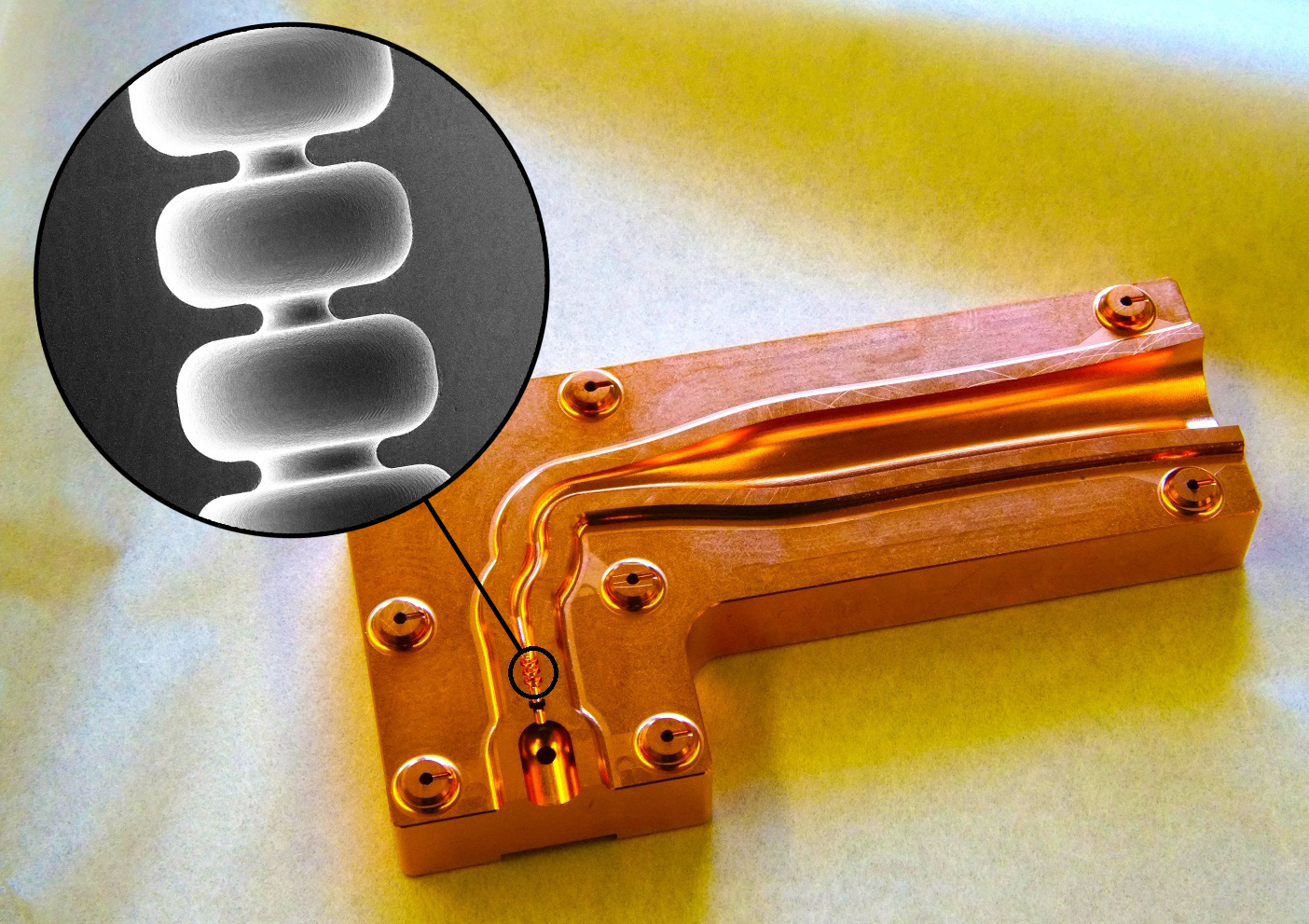SLAC National Accelerator Laboratory has made a new type of accelerator structure that gives 10 times larger energy gain over the same distance in a regular accelerator. Accelerators can be made 10 times shorter or more powerful.
Above – SLAC scientists have invented a copper accelerator structure that could make future X-ray lasers and accelerators for radiation therapy more compact. It feeds terahertz radiation into a tiny cavity to boost particles to tremendous energies. This image shows one half of the structure with the cavity in the circled area. Inset: Scanning electron microscope image of a section of the cavity, which is 3.5 millimeters long and 280 microns wide at its narrowest point. (Chris Pearson/Emilio Nanni/SLAC National Accelerator Laboratory)
The new systems use terahertz radiation to boost particle energies instead of radio-frequency (RF) fields fed into specifically shaped accelerator structures or cavities. Each cavity can deliver only a limited energy boost over a given distance. Very long strings of cavities are needed to produce high-energy beams.
Terahertz waves are 10 times shorter than radio waves, cavities in a terahertz accelerator can also be much smaller. In fact, the one invented in this study was only 0.2 inches long.
This technology will be used for electron guns, next-generation X-ray lasers and electron microscopes. The microscopes allow us to see in real-time how nature works on the atomic level. These beams could also be used for cancer treatment.
ABSTRACT
We report the experimental demonstration of a mm-wave electron accelerating structure powered by a high-power rf source. We demonstrate reliable coupling of an unprecedented rf power—up to 575 kW into the mm-wave accelerator structure using a quasi-optical setup. This standing wave accelerating structure consists of a single-cell copper cavity and a Gaussian to TM01 mode converter. The accelerator structure is powered by 110 GHz, 10-ns long rf pulses. These pulses are chopped from 3 ms pulses from a gyrotron oscillator using a laser-driven silicon switch. We show an unprecedented high gradient up to 230 MV/m that corresponds to a peak surface electric field of more than 520 MV/m. We have achieved these results after conditioning the cavity with more than 105 pulses. We also report preliminary measurements of rf breakdown rates, which are important for understanding rf breakdown physics in the millimeter-wave regime. These results open up many frontiers for applications not only limited to the next generation particle accelerators but also x-ray generation, probing material dynamics, and nonlinear light-matter interactions at mm-wave frequency.
SOURCES- SLAC National Accelerator Laboratory, Applied Physics Letters
Written By Brian Wang, Nextbigfuture.com

Brian Wang is a Futurist Thought Leader and a popular Science blogger with 1 million readers per month. His blog Nextbigfuture.com is ranked #1 Science News Blog. It covers many disruptive technology and trends including Space, Robotics, Artificial Intelligence, Medicine, Anti-aging Biotechnology, and Nanotechnology.
Known for identifying cutting edge technologies, he is currently a Co-Founder of a startup and fundraiser for high potential early-stage companies. He is the Head of Research for Allocations for deep technology investments and an Angel Investor at Space Angels.
A frequent speaker at corporations, he has been a TEDx speaker, a Singularity University speaker and guest at numerous interviews for radio and podcasts. He is open to public speaking and advising engagements.


Have being hearing about much improved accelerators for decades now but there doesn't seem to be any actual projects or products. Seems to be vaporware.
There are no scales for the photographs. Crop much?